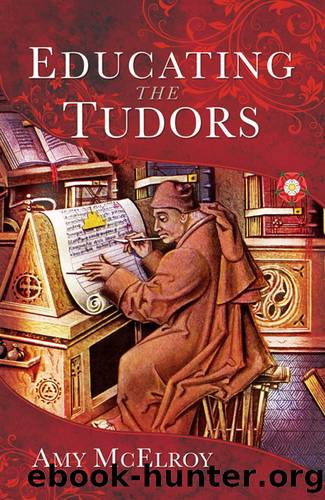Educating the Tudors by Amy McElroy;

Author:Amy McElroy;
Language: eng
Format: epub
Tags: EDUCATION / History
Publisher: Casemate Publishers & Book Distributors, LLC
Published: 2023-03-30T00:00:00+00:00
Chapter Six
Educating the Common People
Children from lower social classes such as the children of husbandmen, craftsmen and labourers, were very lucky to have the opportunity to attend school. Unless they had the opportunity to be sent by a wealthy patron, they were likely to only ever attend a petty school followed by a grammar school in some circumstances if a place could be obtained free of charge. The majority of children from lower classes did not learn to read and write as it was assumed there was no benefit to this. Most did not need to be literate in their work and the opportunities requiring literacy were too far above on the social ladder than most could hope of reaching. For the majority of the children of the lower classes, their education came in the form of learning transferable skills which would enable them to find employment when they grew up. Those of the middle class might receive a formal education but this depended largely on the wealth of the family and the time they could commit to their education. It should be noted that whilst wealthy individuals such as merchants or lawyers did not have titles their wealth opened up possibilities of climbing the social ladder especially as the Tudors were keen to employ men of high intellect. If they were successful in their ambitions, they might well find themselves with a title. For those with wealth, their childrenâs education was likely to be more similar to that of the aristocracy than the poorer children.
Children of the lower classes were taught courtesy. Just like those of the aristocracy, they would be taught how to greet people of rank by doffing their cap and the usual manners taught to all. Although they would be taught to bow and curtsey, unlike the aristocracy they were not expected to be able to perform the perfect pose unless it was thought they would be meeting those it would be required for. This would typically be the wealthier families of the common people who might come into contact with the aristocracy and nobility. The lower classes would likely not need the complex rules of table manners the royal and aristocratic children had to learn as they would likely not have to carve many varieties of meat at a table, or adhere to the rules of the court mealtime rituals. Children of wealthier common families would have learned to ride from an early age, starting with a pony before progressing to a horse. Children of yeomen and husbandmen, although many were not wealthy, also likely leant to ride as their father would use one horse or more for farm work, whilst those of labourerâs might not have the opportunity to learn to ride.
If a child was going to attend school, their first would be a dame school which taught children of both sexes up to the age of seven. The dame schools were not strictly academic and taught other skills such as sewing and spinning, a skill a young girl could practice at home.
Download
This site does not store any files on its server. We only index and link to content provided by other sites. Please contact the content providers to delete copyright contents if any and email us, we'll remove relevant links or contents immediately.
Room 212 by Kate Stewart(4155)
The Crown by Robert Lacey(4143)
Endurance: Shackleton's Incredible Voyage by Alfred Lansing(3894)
The Iron Duke by The Iron Duke(3680)
The Rape of Nanking by Iris Chang(3569)
Killing England by Bill O'Reilly(3491)
Joan of Arc by Mary Gordon(3303)
Say Nothing by Patrick Radden Keefe(3107)
I'll Give You the Sun by Jandy Nelson(2872)
Shadow of Night by Deborah Harkness(2787)
Hitler's Monsters by Eric Kurlander(2770)
Margaret Thatcher: The Autobiography by Thatcher Margaret(2710)
Mary, Queen of Scots, and the Murder of Lord Darnley by Alison Weir(2700)
Darkest Hour by Anthony McCarten(2679)
Blood and Sand by Alex Von Tunzelmann(2635)
Red Famine: Stalin's War on Ukraine by Anne Applebaum(2498)
Eleanor & Park by Rainbow Rowell(2432)
The One Memory of Flora Banks by Emily Barr(2382)
Book of Life by Deborah Harkness(2311)
